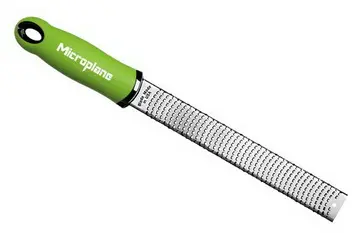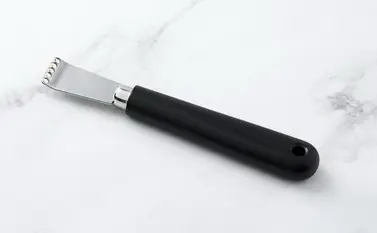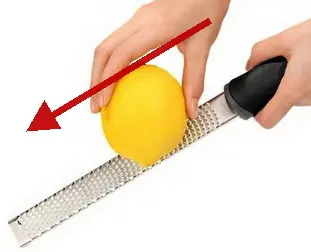This site uses only a few technical cookies necessary for its operation. By continuing to browse, you accept their use.
To find out more...
To find out more...
Zester like a pro

Have you heard of the microplane? It's an extraordinary tool that allows you to grate very, very finely, and therefore zest with disconcerting ease.
Here's some information about it.
Here's some information about it.
8,466 4.9/5 (15 reviews)
Keywords for this post:ZestToolGraterPeelCitrusFineLast modified on: December 25th 2020
Zester like a pro
I'm not telling you anything new, but a lot of recipes use the zest of a fruit, citrus fruits in particular, and removing it is not as easy as you might think.
In fact, you may have already seen this tool here:
It's a zester or a zester knife, which has the advantage of making nice long zests, but which are almost totally exuded, i.e. a little crushed, squeezed, and so the essence of the fruit you're trying to get is more on your fingers or the zester than in the recipe, too bad.
It's more a tool of the past, now there's something much better, and that's the zester grater, it looks like a big file, and as the main brand, the one that launched the tool is Microplane, all the professionals now say one or the microplane.
It doesn't sound like a revolutionary tool, and yet it is. It looks like a large file, as I said, and it's more or less the same principle: tiny teeth in highly resistant stainless steel, and it allows you to zest any fruit you want with extreme finesse, producing a kind of fine powder that blends easily into any recipe, and contains all the essences and flavors of the fruit worked on.
How do you use it? Well, that's the trick: intuitively, you'd use it just like a file: you hold the fruit in one hand, the microplane in the other, and grate the surface, passing it all around the fruit.
Not a good idea, though, as you're going to get zest everywhere but where it needs to be - I'm exaggerating.
No, in fact it's the other way round: your hand holding the microplane doesn't move, it's the one holding the fruit that moves, from the handle to the tip.
And you do this without going back and forth, just one way and then you rotate the fruit a little on itself to zest a new part, and so on.
Well, when you put it like that, it sounds very complicated, and at first it's a bit confusing, this tool that doesn't move while the fruit does, but once you get the hang of it, you'll see. What's more, the amazing quality of the zest harvested is well worth this little change of habit.
The microplane can also be used to grate a whole host of other things, including Parmesan cheese.
Pastry chefs also use it, like a file for that matter, to smooth out their tart, tartelette or cookie bases after baking, for a near-perfect final appearance.
To sum up: to zest a fruit, nothing beats a grater (microplane or other), in which case the tool remains fixed, it's the fruit that moves.
In fact, you may have already seen this tool here:

It's a zester or a zester knife, which has the advantage of making nice long zests, but which are almost totally exuded, i.e. a little crushed, squeezed, and so the essence of the fruit you're trying to get is more on your fingers or the zester than in the recipe, too bad.
It's more a tool of the past, now there's something much better, and that's the zester grater, it looks like a big file, and as the main brand, the one that launched the tool is Microplane, all the professionals now say one or the microplane.

It doesn't sound like a revolutionary tool, and yet it is. It looks like a large file, as I said, and it's more or less the same principle: tiny teeth in highly resistant stainless steel, and it allows you to zest any fruit you want with extreme finesse, producing a kind of fine powder that blends easily into any recipe, and contains all the essences and flavors of the fruit worked on.
How do you use it? Well, that's the trick: intuitively, you'd use it just like a file: you hold the fruit in one hand, the microplane in the other, and grate the surface, passing it all around the fruit.
Not a good idea, though, as you're going to get zest everywhere but where it needs to be - I'm exaggerating.
No, in fact it's the other way round: your hand holding the microplane doesn't move, it's the one holding the fruit that moves, from the handle to the tip.
And you do this without going back and forth, just one way and then you rotate the fruit a little on itself to zest a new part, and so on.

Well, when you put it like that, it sounds very complicated, and at first it's a bit confusing, this tool that doesn't move while the fruit does, but once you get the hang of it, you'll see. What's more, the amazing quality of the zest harvested is well worth this little change of habit.
The microplane can also be used to grate a whole host of other things, including Parmesan cheese.
Pastry chefs also use it, like a file for that matter, to smooth out their tart, tartelette or cookie bases after baking, for a near-perfect final appearance.
To sum up: to zest a fruit, nothing beats a grater (microplane or other), in which case the tool remains fixed, it's the fruit that moves.
Lasts posts
Butter vs. grease
We often read in a recipe where a pastry is put into a mould that, just before pouring, the mould should be buttered or greased. But what's the difference between these 2 terms?December 1st 20251,0085
Getting out of the fridge early
Very often when you're cooking, you need to take food or preparations out of the fridge, to use them in the recipe in progress. There's nothing tricky about this: you just take them out of the fridge and use them, usually immediately, in the recipe. But is this really a good method?November 24th 20251,1365
Who's making the croissants?
When you look at a bakery from the outside, you naturally think that in the bakery, the bakers make the bread, and in the laboratory, the pastry chefs make the cakes. It's very often like that, with each of these professions having quite different ways of working, but sometimes there's also one...November 23th 20251,025
Oven height
When we put a dish or cake in the oven, we naturally tend to put it on the middle shelf, and that's what we usually do. But in some cases, this position and height can be a little tricky, so let's find out why.October 8th 20252,7785
The importance of sieving
In recipes that use a fine powder (flour, powdered sugar, etc.), you'll often see the advice to sift before using it. To sift is to pass the powder in question through a sieve (a very fine strainer) before incorporating it into your recipe. It's often advice, but is it really useful?September 3rd 20257,5443
Other pages you may also like
In praise of Mont d'Or cheese
Do you know the Mont d'Or, this extraordinary cheese from the Haut-Doubs in France, with a unique taste and appearance, which can be eaten both raw and cooked? I'll tell you a few words about it, and with some tips on how to choose it and cook it. .November 27th 202113 K5
Beans in primeur
As I write this, it is the beginning of the short season for fresh beans. If you've never made them before and you're just starting out (and that's a great idea) you'll find that it's a bit time consuming to prepare, you have to shell them once, remove the beans, scald them to remove the skin (and...June 4th 202214 K
In Praise of the Vegetable Mill
When a recipe or preparation calls for something solid to be pureed, as in a soup for example, the natural reflex is to take out the blender and plunge it into the saucepan. This works very well in most cases, but there are times when you'd like to puree something and at the same time remove the...July 12th 202311 K5
Butter doesn't make you fat, unless you eat too much of it.
Whenever I'm discussing cooking and recipes, there is one idea which comes up frequently, like this: "Oh no! But that's got butter in it" (I should add, for the sake of accuracy, that this is something I hear more frequently from women, who are almost all concerned with keeping their figure). ...March 26th 201245 K4.5
Preserving egg yolks
If you're using only the egg whites in a recipe (such as meringues ), you'll need to store the yolks until you're ready to use them again. There's nothing very complicated about this in principle - all you have to do is chill them, but there are a few pitfalls to be avoided in practice.June 18th 20248,1385
Post a comment or question
Follow this page
If you are interested in this page, you can "follow" it, by entering your email address here. You will then receive a notification immediately each time the page is modified or a new comment is added. Please note that you will need to confirm this following.
Note: We'll never share your e-mail address with anyone else.
Alternatively: you can subscribe to the mailing list of cooling-ez.com , you will receive a e-mail for each new recipe published on the site.









